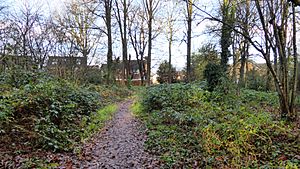Temple Copse facts for kids
Quick facts for kids Temple Copse |
|
|---|---|
 |
|
| Type | Local Nature Reserve |
| Location | Bracknell, Berkshire |
| OS grid | SU 853 702 |
| Area | 1.9 hectares (4.7 acres) |
| Managed by | Bracknell Forest Borough Council |
Temple Copse is a special natural area, about the size of three football fields (1.9 hectares or 4.7 acres). It's located near Bracknell in Berkshire, England. This area is protected as a Local Nature Reserve, which means it's a place where nature is looked after and people can visit to enjoy it.
The local government, Bracknell Forest Borough Council, owns and takes care of Temple Copse. It's one of three similar woodlands in the area, often called "The Three Copses," along with Jock's Copse and Tinkers Copse.
Contents
Exploring Temple Copse's Nature
Temple Copse is an old forest where trees have been managed for a long time using a method called coppicing. This means trees like oak and hazel are cut back regularly, but not completely removed. This helps new shoots grow, providing wood and creating different habitats for wildlife.
You might even spot signs of animals here! There's a special path called a badger run that badgers use to travel between Temple Copse and Tinkers Copse.
A Brief History of Temple Copse
Temple Copse became a protected area in 2002. At that time, the Bracknell Forest Borough Council officially made it a Local Nature Reserve. This decision helps make sure the plants and animals living here are safe and can thrive for many years to come.
Animals You Might Find at Temple Copse
This nature reserve is home to many different creatures. Keep your eyes peeled for these amazing animals!
Mammals Living in the Copse
- European badger: These shy, nocturnal animals are known for their striped faces and strong claws for digging.
- Roe deer: You might see these graceful deer, which are smaller than other deer species, moving quietly through the trees.
- Wood mouse: Tiny and quick, these mice are important parts of the forest's food web.
- Eastern gray squirrel: These common squirrels are busy gathering nuts and seeds, especially in the autumn.
Amphibians and Reptiles
- Grass snake: These non-venomous snakes are often found near water and are good swimmers.
Birds Flying Through the Trees
- Great spotted woodpecker: Listen for their drumming sound as they look for insects in tree trunks.
- Lesser spotted woodpecker: This is the smallest of the European woodpeckers, harder to spot but just as interesting.
- European green woodpecker: Known for their loud, laughing call, these birds often feed on ants on the ground.
- Jay: These colorful birds are part of the crow family and are known for collecting acorns.
- Eurasian bullfinch: Look for the male's bright pink-red chest.
- European robin: A familiar garden bird, known for its red breast.
- Eurasian blue tit: Small, agile birds with blue and yellow feathers.
Insects and Other Invertebrates
- Small tortoiseshell: This beautiful butterfly has orange, black, and yellow patterns on its wings.
Plants Growing at Temple Copse
Temple Copse is also rich in different types of plants, from tall trees to small wildflowers.
Trees of the Woodland
- Sorbus torminalis: Also known as the Wild Service-tree, it has interesting lobed leaves.
- Quercus robur: This is the English oak, a very common and important tree in British woodlands.
- Corylus avellana: Hazel trees are often coppiced and produce tasty nuts.
- Carpinus betulus: Hornbeam trees have hard wood and distinctive ridged bark.
Wildflowers and Other Plants
- Primula vulgaris: This is the common primrose, one of the first wildflowers to appear in spring.
- Lychnis flos-cuculi: Known as Ragged-Robin, it has delicate pink, deeply cut petals.
- Hyacinthoides non-scripta: This is the common bluebell, which creates a beautiful blue carpet in the woodland in spring.

